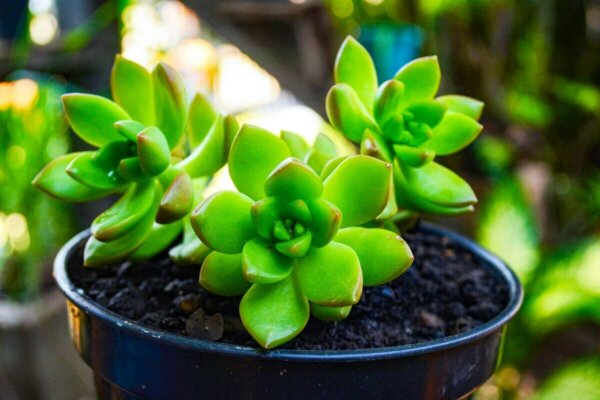This is How You Can Save an Overwatered Plant

One of the most common mistakes gardening lovers make is not properly measuring the amount of water their plants need. In this article, we’re going to tell you how you can save an overwatered plant.
With some very easy tips, that plant you love so much will be as beautiful as ever! Take note and grab your gloves and your gardening tools. It’s time to get to work!
What happens to an overwatered plant?

When you overwater a plant, it can’t exchange gases properly nor absorb all the nutrients it needs. This process is known as root asphyxiation.
Another consequence of excess water and, therefore, lack of oxygenation, is that fungi can affect the plant’s roots. The problem in these cases is that it usually goes undetected for a long time. And by the time it’s detected, not even the best fungicide can save the plant.
These are the symptoms you need to keep an eye out for
To know if you overwater your plant, you need to observe it. Once you’re sure that this is the problem, you can start the entire process to save it. However, don’t do so without being sure.
Here are some of the symptoms your plant can manifest:
- No new sprouts appear.
- The plant is weak.
- Its leaves are growing very slow.
- A yellowish or brownish coloration appears.
- Some leaves and flowers fall off.
- The subsoil seems compacted and may turn greenish.
- The base of the stem narrows.
You must be careful since many of these symptoms are the same that underwatered plants suffer from. So, before taking drastic measures, you should check the state of the soil. To do this, insert your fingers as deeply as possible to check if the subsoil is wet or dry.
How to save an overwatered plant

Let’s start! Once you’ve verified that your plant has been overwatered, you have to get down to work to try to save it. However, keep in mind that this isn’t always possible. Some types of plants are especially susceptible to waterlogging and don’t usually react to anything you do, so you should take this into account to avoid disappointment. Succulents are examples of these plants.
1. Dry your plant
To try to save your plant, the first thing you need to do is remove excess moisture. To do this, you must take it out of the pot and remove all the subsoil that’s stuck to its roots. Let it air dry for about 12 hours. This way, it’ll be able to breathe.
2. Check the state of its roots
Once you reduce the excess moisture, you’ll be able to check the state of its roots. This is key, as your plant will or won’t be able to continue living depending on their state.
If the roots are white, you’re in luck – they’re healthy! On the contrary, if you find black roots or they’ve begun to rot, you’ll have to prune them before planting them again.
We recommend re-planting in another pot, as the old pot may have fungus. But if you like the old pot a lot, wash and disinfect it before planting to make sure it’s completely fungi-free.
To be safe, we recommend applying a fungicide to the roots in case there are traces of fungus. This one from Compo is very good and you can find it at Leroy Merlin.
3. It’s time to transplant
When it comes to saving an overwatered plant, you need to give it a new lease of life and, for this, it must have a nutrient-rich space. Use a good subsoil so the plant can grow properly.
Don’t forget to make sure that the pot you choose has drainage holes. This way, you’ll be able to prevent waterlogging. Plants need to be able to get rid of excess water. This one from Ikea is perfect!
A good tip is to avoid using compost or fertilizer. Remember that the roots are sensitive and could become damaged by all the nutrients these products contain.
Now that you’ve been able to save your overwatered plant, remember to avoid watering it again until the surface layer of the subsoil is dry.
You also need to know the specific care that each plant species requires, as this is the only way you’ll be able to avoid killing your plants.
One of the most common mistakes gardening lovers make is not properly measuring the amount of water their plants need. In this article, we’re going to tell you how you can save an overwatered plant.
With some very easy tips, that plant you love so much will be as beautiful as ever! Take note and grab your gloves and your gardening tools. It’s time to get to work!
What happens to an overwatered plant?

When you overwater a plant, it can’t exchange gases properly nor absorb all the nutrients it needs. This process is known as root asphyxiation.
Another consequence of excess water and, therefore, lack of oxygenation, is that fungi can affect the plant’s roots. The problem in these cases is that it usually goes undetected for a long time. And by the time it’s detected, not even the best fungicide can save the plant.
These are the symptoms you need to keep an eye out for
To know if you overwater your plant, you need to observe it. Once you’re sure that this is the problem, you can start the entire process to save it. However, don’t do so without being sure.
Here are some of the symptoms your plant can manifest:
- No new sprouts appear.
- The plant is weak.
- Its leaves are growing very slow.
- A yellowish or brownish coloration appears.
- Some leaves and flowers fall off.
- The subsoil seems compacted and may turn greenish.
- The base of the stem narrows.
You must be careful since many of these symptoms are the same that underwatered plants suffer from. So, before taking drastic measures, you should check the state of the soil. To do this, insert your fingers as deeply as possible to check if the subsoil is wet or dry.
How to save an overwatered plant

Let’s start! Once you’ve verified that your plant has been overwatered, you have to get down to work to try to save it. However, keep in mind that this isn’t always possible. Some types of plants are especially susceptible to waterlogging and don’t usually react to anything you do, so you should take this into account to avoid disappointment. Succulents are examples of these plants.
1. Dry your plant
To try to save your plant, the first thing you need to do is remove excess moisture. To do this, you must take it out of the pot and remove all the subsoil that’s stuck to its roots. Let it air dry for about 12 hours. This way, it’ll be able to breathe.
2. Check the state of its roots
Once you reduce the excess moisture, you’ll be able to check the state of its roots. This is key, as your plant will or won’t be able to continue living depending on their state.
If the roots are white, you’re in luck – they’re healthy! On the contrary, if you find black roots or they’ve begun to rot, you’ll have to prune them before planting them again.
We recommend re-planting in another pot, as the old pot may have fungus. But if you like the old pot a lot, wash and disinfect it before planting to make sure it’s completely fungi-free.
To be safe, we recommend applying a fungicide to the roots in case there are traces of fungus. This one from Compo is very good and you can find it at Leroy Merlin.
3. It’s time to transplant
When it comes to saving an overwatered plant, you need to give it a new lease of life and, for this, it must have a nutrient-rich space. Use a good subsoil so the plant can grow properly.
Don’t forget to make sure that the pot you choose has drainage holes. This way, you’ll be able to prevent waterlogging. Plants need to be able to get rid of excess water. This one from Ikea is perfect!
A good tip is to avoid using compost or fertilizer. Remember that the roots are sensitive and could become damaged by all the nutrients these products contain.
Now that you’ve been able to save your overwatered plant, remember to avoid watering it again until the surface layer of the subsoil is dry.
You also need to know the specific care that each plant species requires, as this is the only way you’ll be able to avoid killing your plants.







